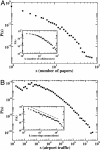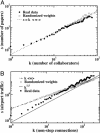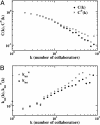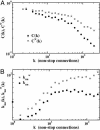The architecture of complex weighted networks
- PMID: 15007165
- PMCID: PMC374315
- DOI: 10.1073/pnas.0400087101
The architecture of complex weighted networks
Abstract
Networked structures arise in a wide array of different contexts such as technological and transportation infrastructures, social phenomena, and biological systems. These highly interconnected systems have recently been the focus of a great deal of attention that has uncovered and characterized their topological complexity. Along with a complex topological structure, real networks display a large heterogeneity in the capacity and intensity of the connections. These features, however, have mainly not been considered in past studies where links are usually represented as binary states, i.e., either present or absent. Here, we study the scientific collaboration network and the world-wide air-transportation network, which are representative examples of social and large infrastructure systems, respectively. In both cases it is possible to assign to each edge of the graph a weight proportional to the intensity or capacity of the connections among the various elements of the network. We define appropriate metrics combining weighted and topological observables that enable us to characterize the complex statistical properties and heterogeneity of the actual strength of edges and vertices. This information allows us to investigate the correlations among weighted quantities and the underlying topological structure of the network. These results provide a better description of the hierarchies and organizational principles at the basis of the architecture of weighted networks.
Figures







References
-
- Albert, R. & Barabási, A.-L. (2002) Rev. Mod. Phys. 74, 47-97.
-
- Dorogovtsev, S. N. & Mendes, J. F. F. (2003) Evolution of Networks: From Biological Nets to the Internet and WWW (Oxford Univ. Press, Oxford).
-
- Watts, D. J. & Strogatz, S. H. (1998) Nature 393, 440-442. - PubMed
-
- Barabási, A.-L & Albert, R. (1999) Science 286, 509-512. - PubMed
Publication types
MeSH terms
LinkOut - more resources
Full Text Sources
Other Literature Sources
Miscellaneous

